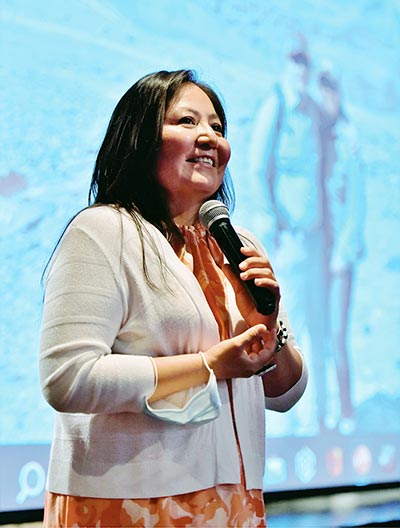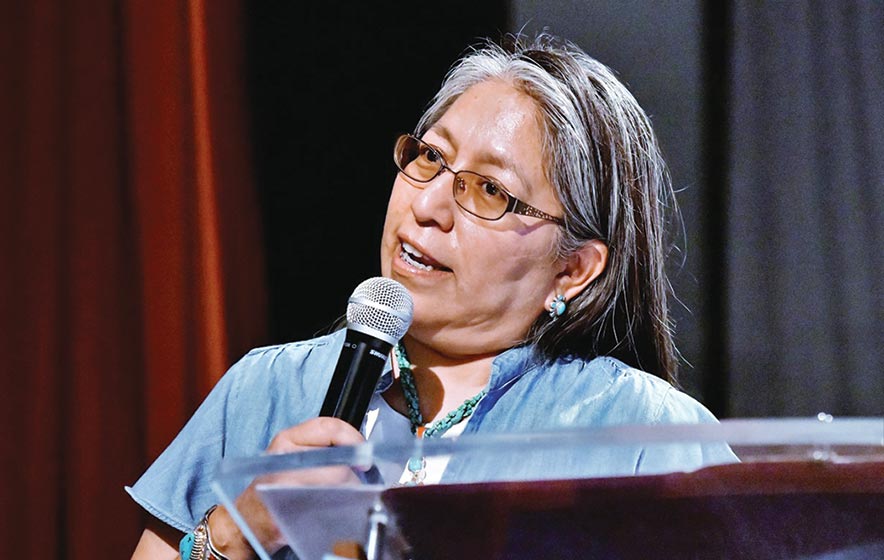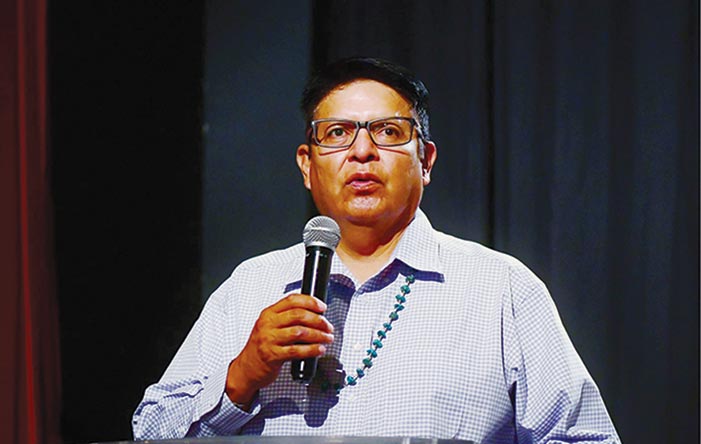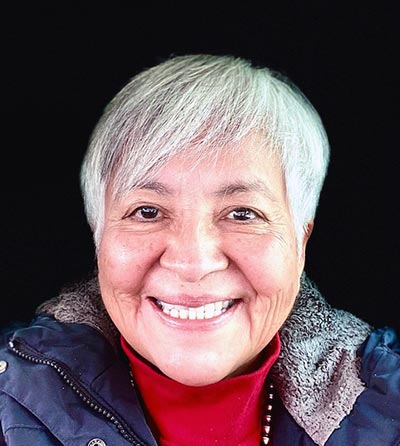
Guest Column | Diné grads offer insights on Navajo education
By Bazhnibah
Special to the Times
WINDOW ROCK

Special to the Times | Bazhnibah
Dr. Miranda Tsosie speaks on her research, “The transformative influence of stories in the lives of Navajo women: A narrative inquiry,” at the 6th annual Education Conference on Thursday, July 28, at the Navajo Nation Museum.
It is truly startling to hear that our Navajo / Diné language is endangered today.
Taylor Notah, a Cronkite News reporter, in 2017 reported on the percentages of Navajo children who speak the language entering kindergarten.
She mapped out the percentages as follows: 95% of the Navajo kindergarten spoke Navajo in 1969, 53% of them spoke Navajo in 1993, and only 30% spoke Navajo in 2009.
There have not been any recent studies on the percentages for kindergarten or any Navajo child in school who speak Navajo.
Is the language important for the Navajo people or is it not?
Recently, the 6th annual Navajo Education conference was held at the Navajo Nation Museum in Window Rock. Navajo scholars conveyed messages of the importance of learning the Navajo language.
Dr. Henry Fowler is faculty in mathematics at Navajo Technical University and the Fielding Graduate University. Fowler is well-known for his work with Navajo math circles, which combine the Navajo language and culture with math and considers using symmetry, shapes, and transformations seen in rug weaving, basket making and other traditional work.
His work has inspired many students to excel in mathematics.
Dr. Michelle Tsosie presented her work, “the transformative influence of stories in the lives of Navajo women: A narrative inquiry.
She studied Navajo women and their influences by their Navajo culture, traditions, and stories they have learned in their daily activities. From this inquiry she reported that Navajo women gained culturally from reciprocity of respectful relationships with family and community, from the wisdom of matriarchs and patriarchs, and from knowing Hozho: balance and harmony in life.
“The Head Start children” was the study done by Dr. Rolanda Billy. The qualitative study consisted of interviews with teachers on the Navajo Nation.

Special to the Times | Bazhnibah
Dr. Miranda Haskie, talks about her study, “Intergenerational journey preserving the Navajo language,” at the 6th annual Education Conference at the Navajo Nation Museum.
The study revealed that teaching colors, clans and kinships, rug weaving, counting, shapes and providing cultural foods in the classroom were successful lessons. It also emphasized that extending lessons to the home and families were needed.
Dr. Perphelia Fowler interviewed Navajo female leaders with bachelor’s degrees or higher to learn how and what in Navajo culture influenced them to become leaders, in her study.
Some characteristics found in the women were talents of inspiration, self-direction, relationships, communication and self-awareness which helped in their leadership role today.
The second day opened with a welcome by President Jonathan Nez who stressed “oral teachings are important in knowing who we are as Diné people, it is our way of life teaching.”
Other Navajo scholars speaking included Dr. Miranda Haskie and Barsine Onyenedo.
Haskie, a professor of sociology at Dine College and adjunct faculty with Fielding Graduate University, presented her work, “An intergenerational journey preserving the Navajo language.”
She pointed out that 51% of the Navajo population live on the Nation and that 49% live in urban areas. Statistically, there are 48% male and 52% female Navajos.
She reported that in a 1991 research study, 66% of Navajo people spoke Navajo at home. In 1980, 93% spoke Navajo while in 2020, only 51% spoke the language.

Special to the Times | Bazhnibah
Dr. Henry Fowler, associate professor of math and adjunct faculty member at Navajo Technical University and the Fielding Graduate University, opens the 6th annual Education Conference at the Navajo Nation Museum in Window Rock.
Onyenedo, Diné College early childhood education faculty, “infuses the language lineage tree to approach an educator’s understanding of the importance of language and culture in the educational K-12 system and beyond.”
She uses the concept of the lineage tree to enlighten students to teach Navajo and to bring greater awareness of embracing language in schools.
The conference closed with statements from Rose Graham, director of the Office of Navajo Nation Scholarship and Financial Aid, who said the Nation needs to grow its own educators but struggles with those students who leave to attend college but do not come back to serve on the Nation.
Recommendations for the education of the Navajo youth emerged from this conference including 1) integrating Navajo culture and language into curriculum; 2) striving to become bilingual; 3) preserving the language; and 4) starting language and culture education with the young, with families, and the community.
The Fielding Graduate University was one of the sponsors of this annual education conference. Their new published book, “The future of Navajo education,” talks about innovative ways that Navajo educators can use resources and research to tackle educational needs of the Navajo people.

Ruth (Bazhnibah) Kawano
Bazhnibah, or Ruth Kawano, is a photographer, writer and retired registered nurse and U.S. Air Force captain.








 Highway 264,
Highway 264, I-40, WB @ Winslow
I-40, WB @ Winslow